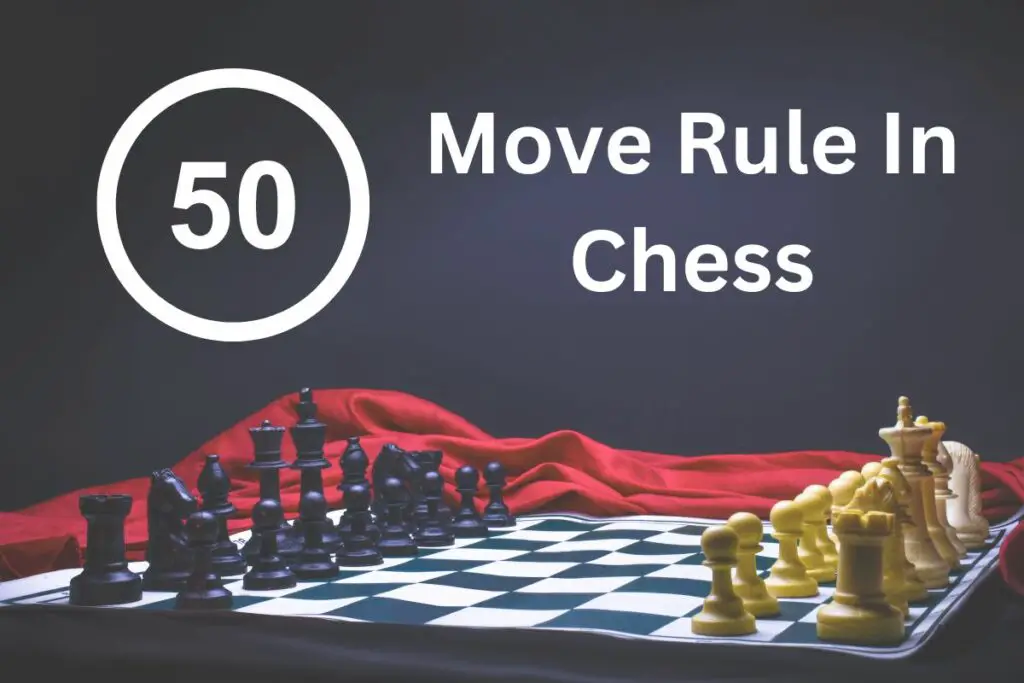Chess is a board game that has been around for centuries and has been enjoyed by people of all ages. One of the most important rules in chess is the 50-move rule – but do you know what it is? And how it works?
In chess, the 50-move rule states that if 50 consecutive moves have been made by both players without any capture or pawn movement, either player can claim a draw. This rule is meant to prevent games from going on endlessly without any progress being made.

In this blog post, we will discuss the 50-move rule in more detail and provide tips on avoiding reaching a stalemate. Keep reading to learn about the fascinating history of this rule and how to navigate it successfully!
What Is The 50 Move Rule In Chess?
In chess, the 50-move rule is a way to determine if a game is a draw. According to the rule, the game is a draw if neither player has made a capture or a pawn move in the last 50 moves.
This can happen if both players only move their pieces around without any real purpose. The 50-move rule exists to prevent games from going on forever without any resolution.
There are some exceptions to the 50-move rule. For example, if a player has only a king and bishop left, it is possible to force a checkmate in fewer than 50 moves. Similarly, if a player has only a king and knight, it is possible to force a checkmate in fewer than 50 moves.
If either of these situations arises, the 50-move rule does not apply, and the game can continue. Here are some pointers to consider when using the 50-move rule:
- Keep track of the number of moves made by both players. This can be quickly done using a chess clock or keeping count on a notepad.
- Look for opportunities to make captures or pawn moves to avoid reaching 50 consecutive moves without them.
- If 50 moves have transpired without any captures or pawn movements, it is important to notify your opponent and claim a draw before making any more moves.
- Violating the 50-move rule by not claiming a draw can result in penalties, such as losing points in a tournament setting.
- If a game ends in a draw because of the 50-move rule, it will still count as half a win and half a loss for both players in tournament settings.
Understanding and following the 50-move rule can prevent a game from dragging on endlessly or risking a penalty for improper claiming of a draw. By keeping track of moves and making strategic captures and pawn movements, players can avoid reaching the 50-move limit and keep the game moving and progressing.
The History Of The 50 Move Rule
The 50-move rule has been a part of chess for centuries, with the first known reference dating back to 1497. The rule stipulates that a player can claim a draw if there have been 50 moves without a capture or pawn advance and neither player is in checkmate.
The rule is intended to prevent draws by mutual agreement and provide a way to end games that are not progressing toward a checkmate. In 1996, the rule was changed so a player could only claim a draw after their opponent had made their 50th move.
This change was made to discourage players from deliberately making moves that did not progress the game, to claim a draw.
The future of the 50-move rule is unclear, as there have been calls for it to be abolished or amended in recent years. However, it remains an essential part of chess and will likely continue for many years to come.
When Does The 50 Move Rule Apply?
The 50-move rule applies in all official tournaments and matches, as it is a part of the official chess rules set by the World Chess Federation (FIDE ).
).
However, this rule does not apply in casual games or online play. Players can agree to use the 50-move rule in casual games, but it is not required. In some street games, players will use the 16-move rule to draw instead. However, that is not an official chess rule.
In a tournament or match setting, players must adhere to the 50-move rule and claim a draw if they have not made a capture or pawn advance in 50 consecutive moves. Failure to do so can result in penalties, such as losing points.
How Can You Avoid A 50-Move Rule Draw?
One way to avoid a 50-move rule draw is by making sure that any pawn moves or captures are done strategically to prevent an endless cycle. Additionally, try to constantly mix up your moves to avoid falling into a repetitive pattern.
Another strategy is to exchange pieces, particularly the queen, as this can significantly reduce the number of moves made without a capture or pawn advance.
It is also important to keep track of the number of moves made without a capture or pawn advance, as exceeding 50 moves in this way will result in a draw being declared. This can be quickly done by keeping a running tally or using a chess clock with an automatic 50-move counter.
Conclusion
It is important to understand and adhere to the 50-move rule in tournament and match play to avoid any penalties or unsatisfying endings to your games. By following these guidelines, you can ensure that your chess games have exciting and definitive conclusions.
